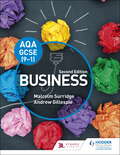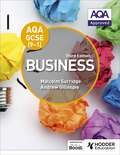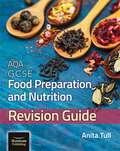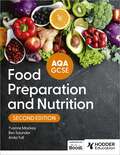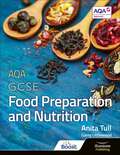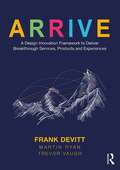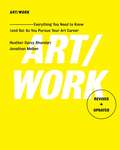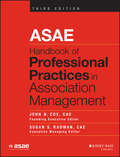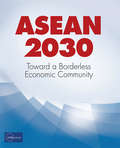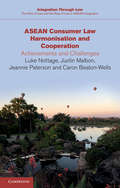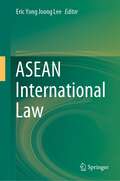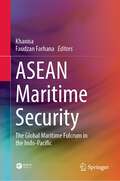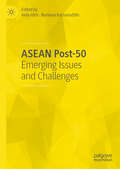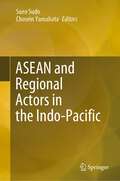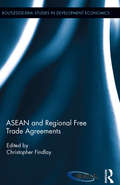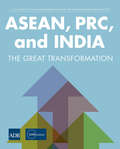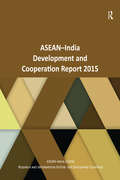- Table View
- List View
AQA GCSE (9-1) Business
by Malcolm Surridge Andrew GillespieSelected for an AQA approval processBenefit from the expert guidance of Surridge and Gillespie; this new edition of their well-known Student Book provides up-to-date content, real business examples and assessment preparation materials that help every student achieve their best in the 2017 specification. Builds understanding of business concepts through accessible explanations, supported by definitions of key terms and tips that highlight important points and common misconceptions. Enables students to apply their knowledge to real business examples, issues and contexts in the 'Business insight' feature. Develops investigative, analytical and evaluation skills through multiple choice, short answer and case study/data response questions, sample answers and commentary. Encourages students to track their progress using learning outcomes, end-of-chapter summaries and knowledge-check questions. Helps students practise and improve their quantitative skills via the 'Maths moment' feature. Stretches students with questions that test their ability to make an informed judgement.
AQA GCSE (9-1) Business, Third Edition
by Malcolm Surridge Andrew GillespieWith up-to-date case studies of real-world businesses, this fully updated AQA GCSE (9-1) Business Student Textbook will help your students respond to exam questions with confidence, demonstrating how they can structure their answers for maximum impact. This Student Textbook includes:- Fully up-to-date exam questions, with 25% more practice questions and increased practical support for tackling different question types- More exam tips and advice, with examiner commentary showing how students should approach exam questions- Real-world case studies, new and updated, to reflect the developments in e-commerce and the impact of recent global and political developments- Quick knowledge-recall questions throughout the book to help students check understanding, and for teachers to use in assessment
AQA GCSE (9-1) Business, Third Edition
by Malcolm Surridge Andrew GillespieWith up-to-date case studies of real-world businesses, this fully updated AQA GCSE (9-1) Business Student Textbook will help your students respond to exam questions with confidence, demonstrating how they can structure their answers for maximum impact. This Student Textbook includes:- Fully up-to-date exam questions, with 25% more practice questions and increased practical support for tackling different question types- More exam tips and advice, with examiner commentary showing how students should approach exam questions- Real-world case studies, new and updated, to reflect the developments in e-commerce and the impact of recent global and political developments- Quick knowledge-recall questions throughout the book to help students check understanding, and for teachers to use in assessment
AQA GCSE Food Preparation & Nutrition: Revision Guide
by Anita TullWritten by leading food author Dr Anita Tull, this revision guide provides you with reassuring support as you study through the course, and all the essential knowledge you need to revise for your written exam. // The information is presented in a colourful and highly visual way. // Summaries are included for every topic in the course. // Mindmaps help you remember what you are revising. // Key terms you need for your exam answers are provided for every topic. // Activities help you learn the topics and test your knowledge. // Revision Tips give you ideas and suggestions about different ways of revising. // Exam skills and techniques are reinforced with a dedicated chapter of advice and guidance. // Practice exam-style questions (with answers available) enable you to test yourself and provide plenty of practice for the exam.
AQA GCSE Food Preparation and Nutrition Second Edition
by Anita Tull Yvonne Mackey Bev SaunderThis title has been submitted for approval by AQA.Motivate all learners to build their knowledge and skills so they can approach both practical and written assessments with confidence. Written by a leading author team, our new edition textbook has been specifically designed to provide comprehensive, accessible and engaging content for AQA GCSE Food Preparation and Nutrition.- Easily deliver your course with structured and comprehensive coverage of the specification, supporting both specialist and non-specialist teachers- Enable students of all ability levels to progress, with accessible language, clear layout and photographs used throughout to bring the content to life- Help students understand the relevance of food science with revised content, including more scaffolding and guidance on how to apply their knowledge in the context of assessment- Build students' knowledge and skills with key term definitions, study tips and activities, including practical tasks to help them prepare for the NEA component- Consolidate learning with short practice questions that check understanding, plus exam-style questions to help students prepare for assessment, with all answers provided in the book
AQA GCSE Food Preparation and Nutrition Second Edition
by Anita Tull Yvonne Mackey Bev SaunderThis title has been submitted for approval by AQA.Motivate all learners to build their knowledge and skills so they can approach both practical and written assessments with confidence. Written by a leading author team, our new edition textbook has been specifically designed to provide comprehensive, accessible and engaging content for AQA GCSE Food Preparation and Nutrition.- Easily deliver your course with structured and comprehensive coverage of the specification, supporting both specialist and non-specialist teachers- Enable students of all ability levels to progress, with accessible language, clear layout and photographs used throughout to bring the content to life- Help students understand the relevance of food science with revised content, including more scaffolding and guidance on how to apply their knowledge in the context of assessment- Build students' knowledge and skills with key term definitions, study tips and activities, including practical tasks to help them prepare for the NEA component- Consolidate learning with short practice questions that check understanding, plus exam-style questions to help students prepare for assessment, with all answers provided in the book
AQA GCSE Food Preparation and Nutrition: Revision Guide
by Garry Littlewood Anita TullApproved by AQA, this student book offers high quality support you can trust. Written by renowned author Anita Tull and Garry Littlewood, this resource is designed to be the most motivating student-friendly book available. Its engaging visual style and tone will support your students through this new course and help them thoroughly prepare for both their non-examined assessment tasks and exam. / Designed for students of all ability level. / Knowledge and understanding covers the specification content in the right level of detail and is written and presented in a highly accessible way. / Recipes make the links between food preparation skills and the science of food and nutrition. / Practical activities help your students connect theory and practice, and apply their understanding of food and nutrition to practical preparation. / Non-Exam Assessment tasks are supported with a chapter giving you clear guidance on how you will be assessed./Exam practice and skills guidance is provided, introducing students to the assessment criteria and mark schemes. / Extension questions and tasks will help stretch and challenge the most able learners.
AQR's Momentum Funds (A)
by Randolph B. Cohen Daniel B. Bergstresser Lauren H. Cohen Christopher MalloyAQR is a hedge fund based in Greenwich, Connecticut, that is considering offering a wholly new line of product to retail investors, namely the ability to invest in the price phenomenon known as momentum. There is a large body of empirical evidence supporting momentum across many different asset classes and countries. However, up until this point, momentum was a strategy employed nearly exclusively by hedge funds, and thus not an available investment strategy to most individual investors. This case highlights the difficulties in implementing this "mutual fund-itizing" of a hedge fund product, along with the challenges that the open-end and regulatory features that a mutual fund poses to many successful strategies implemented in other contexts. In addition, it gives students the ability to calculate and interpret various horizons of correlations between many popular investment strategies using long time-series data and then thinking about the potential complementarities of strategies from a portfolio construction context.
ARISE: A Destination-for-a-Day Spa
by Michael Beer Lynda St. ClairA new Dallas-based health and beauty spa aims to use a highly distinctive human resource system as the foundation of its competitive strategy. By encouraging employees to act as "personal wellness coaches" (PWCs) with high commitment and broad responsibilities, the leadership intended to provide a level of client service that would justify premium rates. However, the system is not working. Issues include: tips are lower than expected, reducing expected compensation; scheduling issues create bottlenecks; and the level of commitment varies among PWCs. The result is a high employee turnover rate, and departing employees take an average of 35% of their client base with them when they go. Now, with financials for the spa's second year completed, the VP of spa operations, the VP of business operations, and the CEO must evaluate what is and what isn't working.
ARRIVE: A Design Innovation Framework to Deliver Breakthrough Services, Products and Experiences
by Frank Devitt Martin Ryan Trevor VaughThis book is an excellent best-practice guide for senior managers and directors with innovation responsibilities. It describes how organisations of all sizes and sectors can apply design thinking principles coupled with commercial awareness to their innovation agenda. It explains how to keep the customer experience at the centre of innovation efforts and when to apply the range of available practices. It provides a clear, extensive rationale for all advice and techniques offered. Design thinking has become the number one innovation methodology for many businesses, but there has been a lack of clarity about how best to adopt it. It often requires significant mindset and behavioural changes and managers must have a coherent and integrated understanding in order to guide its adoption effectively. Many design thinking implementations are inadequate or sub-optimal through focusing too much on details of individual methods or being too abstract, with ill-defined objectives. This book uniquely provides integrated clarity and rationale across all levels of design thinking practice and introduces the ARRIVE framework for design thinking in business innovation, which the authors have developed over ten years of practice and research. ARRIVE = Audit – Research – Reframe – Ideate – Validate – Execute. The book contains a chapter for each of A-R-R-I-V-E, each of which has explanatory background and step-by-step methods instruction in a clear and standard format. Using the ARRIVE framework, the book provides high-level understanding, rationale and step-by-step guidance for CEOs, senior innovation leaders, innovation project managers and design practitioners in diverse public and private sectors. It applies equally well to innovation of products, services or systems.
ART/WORK: Everything You Need to Know (and Do) As You Pursue Your Art Career
by Heather Darcy Bhandari Jonathan MelberThe definitive, must-have guide to pursuing an art career—the fully revised and updated edition of Art/Work, now in its fourteenth printing, shares the tools artists of all levels need to make it in this highly competitive field.Originally published in 2009, Art/Work was the first practical guide to address how artists can navigate the crucial business and legal aspects of a fine art career. But the rules have changed since then, due to the proliferation of social media, increasing sophistication of online platforms, and ever more affordable digital technology. Artists have never had to work so hard to distinguish themselves—including by making savvy decisions and forging their own paths. Now Heather Bhandari, with over fifteen years of experience as a director of the popular Chelsea gallery Mixed Greens, and Jonathan Melber, a former arts/entertainment lawyer and director of an art e-commerce startup, advise a new generation of artists on how to make it in the art world. In this revised and updated edition, Bhandari and Melber show artists how to tackle a host of new challenges. How do you diversify income streams to sustain a healthy art practice? How can you find an alternative to the gallery system? How do you review a license agreement? What are digital marketing best practices? Also included are new quotes from over thirty arts professionals, updated commission legal templates, organizational tips, tax information, and advice for artists who don’t make objects. An important resource for gallerists, dealers, art consultants, artist-oriented organizations, and artists alike, Art/Work is the resource that all creative entrepreneurs in the art world turn to for advice.
ASAE Handbook of Professional Practices in Association Management
by John B. Cox Susan S. RadwanA new edition of one of the flagship books for CAE preparation The ASAE Handbook of Professional Practices in Association Management covers the core functions of association management at a high but practical level, making it a go-to resource for professionals who are leading and managing membership organizations and those preparing for the Certified Association Executive (CAE) credential. Now in its third edition, this core text in the ASAE association literature offers practical, experience-based insights, strategies, and techniques for managing every aspect of an association or membership organization. Organized into 35 chapters and presenting information based on experience and proven research into the skills and knowledge required for successfully managing an organization of any size, this book covers governance and structure, leadership processes, management and administration (including finance and human resources), internal and external relations, programs and services, and much more. This new edition incorporates increased emphasis on the c-level judgment required of Certified Association Executives and CEO-aspirants, as well as more comprehensive coverage of essential functions such as planning. Covers the range of functions essential to managing an association Serves as a flagship handbook for CAE prep and is one of only five designated "CAE Core Resources"; new edition is applicable to prep beginning with the May 2015 CAE exam Information is relevant and applicable to students and professionals alike Edited by the founding editor of Professional Practices in Association Management and a CAE instructor with more than 30 years of experience in preparing CAEs Put the experts to work for you with this essential resource--written by association professionals and experts with 300 years of cumulative experience!
ASEAN 2030: Toward a Borderless Economic Community
by AdbiThis book investigates long-term development issues for members of the Association of Southeast Asian Nations (ASEAN). It finds that with the proper policy mix--including domestic structural reforms and bold initiatives for regional integration--ASEAN has the potential to reach by 2030 the average quality of life enjoyed today in advanced economies and to fulfill its aspirations to become a resilient, inclusive, competitive, and harmonious (RICH) region. Key challenges moving forward are to enhance macroeconomic and financial stability, support equitable growth, promote competitiveness and innovation, and protect the environment. Overcoming these challenges to build a truly borderless economic region implies eliminating remaining barriers to the flow of goods, services, and production factors; strengthening competitiveness and the institutional framework; and updating some governing principles. But ASEAN should not merely copy the European Union. It must maintain its flexibility and pragmatism without creating a bloated regional bureaucracy. The study's main message is that through closer integration, ASEAN can form a partnership for achieving shared prosperity in the region and around the globe.
ASEAN Champions
by Park Seung Ho Ungson Gerardo Rivera Francisco Jamil Paolo S.With a population of about six hundred million people, and a combined GNP of more than US$ 2. 4 trillion, the ASEAN Economic Community (AEC) is set to become the seventh largest economy in the world. Launched in December 2015, the AEC unveiled initiatives to create a single market and production zone, a competitive and equitable region, and integrated links to the global economy. ASEAN Champions seeks to address the role of the strong local firms in regional integration, how these 'champions' succeeded and endured, despite facing adverse circumstances, and the factors that facilitated or impeded their participation in regional integration. The book provides insights for future firm and government-led strategies to enhance the integration process. By complementing current narratives that focus on macroeconomic, socio-political, and trade considerations, Park, Ungson and Francisco offer an enlightening and engaging read, ideally suited to academics and professionals alike.
ASEAN Consumer Law Harmonisation and Cooperation: Achievements and Challenges (Integration through Law:The Role of Law and the Rule of Law in ASEAN Integration #18)
by Caron Beaton-Wells Justin Malbon Luke Nottage Jeannie PatersonThis is the first Western-language research monograph detailing significant developments in consumer law and policy across the Association of Southeast Asian Nations (ASEAN), underpinned by a growing middle class and implementation of the ASEAN Economic Community from 2016. Eight chapters examine consumer law topics within ASEAN member states (such as product safety and consumer contracts) and across them (financial and health services), as well as the interface with competition law and the nature of ASEAN as a unique and evolving international organisation. The authors include insights from extensive fieldwork, partly through consultancies for the ASEAN Secretariat, to provide a reliable, contextual and up-to-date analysis of consumer law and policy development across the region. The volume also draws on and contributes to theories of law and development in multiple fields, including comparative law, political economy and regional studies.
ASEAN Industries and the Challenge from China
by Anthony Welch Darryl S.L. JarvisThis book explores the impact of the rise of China on South East Asia, addressing the consequences for some of Asia's key economic sectors, including educational services, bio-technology, financial services, and the food industry, among others.
ASEAN International Law
by Eric Yong Joong LeeThis book consists of updated and refreshed papers written by international law scholars and practitioners from the ASEAN region and published by the Journal of East Asia and International Law, comprehensively covering almost all contemporary international legal issues related to ASEAN.Legal analysis of the ASEAN integration as one community with one vision in this book provides readers with a better understanding of the current social climate and future developments of ASEAN. Each section within the book covers a highly topical issue on ASEAN cooperation and dispute resolution from an international law perspective. ASEAN is one of the biggest economic communities in the world and the ASEAN+3 covers nearly half of global GDP. Given the region’s global impact, this book is of interest to Asia watchers, academics and policymakers alike.
ASEAN Maritime Security: The Global Maritime Fulcrum in the Indo-Pacific
by Khanisa Faudzan FarhanaThis book covers various strategic issues around maritime security in terms of how Indonesia has sought to implement its Global Maritime Fulcrum (GMF) vision, evaluating its regional impact within ASEAN. The Global Maritime Fulcrum’ vision was declared by President Joko Widodo to refocus Indonesia’s development paradigm to prioritize its maritime aspect in the Indo-Pacific. Divided across five pillars, namely: maritime culture, maritime resource management, maritime infrastructure and connectivity development, maritime diplomacy and maritime defense, the book presents that the implementation of this vision will doubtless have a significant regional impact, particularly in setting regional maritime agendas. In promoting an understanding of the challenges presented in implementing the Global Maritime Fulcrum and unpacking its multifaceted impact in the region, this book delves into Indonesia’s maritime vision, the existing maritime arrangements within ASEAN, and Indonesia’s interests in terms of its political economy relating to the maritime sector, strategic security issues, maritime diplomacy, and related regional power dynamics. Translated from Bahasa Indonesia into English, the book is relevant to scholars and policymakers in maritime studies, international relations, and regional studies relating to politics and power dynamics in Indonesia, specifically, and ASEAN more broadly.
ASEAN Post-50: Emerging Issues and Challenges
by Aida Idris Nurliana KamaruddinThe first 50 years of ASEAN integration has brought peace and prosperity to the Southeast Asian region, while the next 50 will undoubtedly be fraught with unprecedented challenges. Today ASEAN not only has to contend with its own internal challenges arising from the highly diverse political, economic and socio-cultural systems of its member countries, it also has to deal with external factors which include shifts in geostrategic balance, fraying global consensus on free trade, populism and xenophobia, climate change, digital revolutions and cybercrimes.Set against the above background, this edited collection considers some of the contemporary issues and challenges faced by ASEAN in its journey towards more cohesive and dynamic regional integration. Among the topics explored are ASEAN’s evolving partnerships with its key strategic partners including China and the United States on economic policies and strategies, educational systems and frameworks, migration and environmental threats.
ASEAN and Regional Actors in the Indo-Pacific
by Sueo Sudo Chosein YamahataThis book discusses the shifting regional geopolitical engagements and development of rearranged connections emerging among ASEAN and non-ASEAN actors.First, the book focuses on the crucial discourse surrounding the Indo-Pacific region, including its challenges, continuity, and relevance. The discussion highlights the growing influence of regional actors such as India, Thailand, Japan, and the US, particularly in the context of a pressing question of collaboration versus containment amidst China’s rise. The book delves into various topics, such as geopolitical anxieties, economic strength, foreign policy, international relations, development, and security promotion in South and Southeast Asia, through the lenses of ASEAN centrality and the Indo-Pacific strategy.Second, the volume emphasizes on the escalating tensions and the worsening crises in the region that cause major anxieties and the subsequent realignment and new alignment of countries’ relationships. Among several chapters of the volume, a large Indo-China state, Myanmar, takes a special place in the book’s discussions as it has grown as an important ground for a resource/energy race among geopolitically strategic partners. Additionally, Myanmar has the potential to become a balancer in ASEAN. Therefore, any positive development and change in course of relations to Myanmar, particularly with its neighbors, Japan, and Russia, in both historical and contemporary contexts, can have a significant impact not only on Myanmar’s course towards peace, democracy, and security, but also regional stability. The editors and contributors examine the unique position of ASEAN, with a focus on ASEAN centrality as a platform for addressing anxieties and building relationships to bridge the gap between world and regional players, including both friends and foes.Overall, the volume provides valuable insights into the Indo-Pacific region’s complex dynamics, including cooperation and collaboration among regional actors for long-term stability and prosperity. The interdisciplinary composition of the book invites readers from various backgrounds to engage with constructive debates on general perception, contextual discussion, and the highlights of engaged research from local and international perspectives.
ASEAN and Regional Free Trade Agreements (Routledge-ERIA Studies in Development Economics)
by Christopher FindlayEfforts to use existing trade agreements to build a larger regional agreement face many challenges. This book considers this problem with reference to ASEAN’s current agreements with key partners and the interest to build the Regional Comprehensive Economic Partnership (RCEP). The analysis of the options is framed by a focus on the use of supply chains in international business. Issues considered include those related to reductions in tariffs, trade facilitation, the treatment of investment and of services and the definition of rules of origin. The work is informed by case studies of supply chains in automobile and electronics, and in a professional service sector. The book provides a set of priority actions for better progress in taking a bottom-up approach to building RCEP.
ASEAN, PRC, and India: The Great Transformation
by Adbi AdbAsia's remarkable economic performance and transformation since the 1960s has shifted the center of global economic activity toward Asia, in particular toward the Association of Southeast Asian Nations (ASEAN) economies, the People's Republic of China, and India (collectively known as ACI). While these dynamic developing economies do not form any specific institutional group, they constitute very large economies and markets. These emerging Asian giants share common boundaries, opportunities, and challenges. Their trade, investment, production, and infrastructure already are significantly integrated and will become more so in the coming decades. This book focuses on the prospects and challenges for growth and transformation of the region's major and rapidly growing emerging economies to 2030. It examines the drivers of growth and development in the ACI economies and the factors that will affect the quality of development. It also explores the links among the ACI economies and how their links may shape regional and global competition and cooperation.
ASEAN-India Development and Cooperation Report 2015
by Asean�India CentreIndia‘s engagement with the Association of Southeast Asian Nations (ASEAN) is at the heart of its Look East Policy. As a regional bloc, ASEAN has developed much faster than any of the other blocs in the Asia-Pacific. With ASEAN and India working towards establishing a Comprehensive Free Trade Area through Regional Comprehensive Economic Partnership Agreement (RCEP), their cooperation will be key to promoting economic stability, competitiveness, growth and integration in the region. This Report: provides a comparative analysis of the global and regional economies; examines the impact and implications of India ASEAN integration; assesses policy priorities, effectiveness, implementation imperatives and challenges; and discusses themes central to the economic sustainability of the region, including public and foreign policy, trade facilitation, financial and scientific cooperation, food security, energy cooperation, and productivity and opportunities in the manufacturing and service sectors. It will be invaluable to scholars and researchers of economics, international relations, development studies, area studies, as well as policy-makers, administrators, private sector professionals, and non-governmental organisations in the field.
ASICS: Chasing a 2020 Vision
by Nobuo Sato Elie Ofek Akiko KannoIn early 2016, Motoi Oyama, president and CEO of ASICS, a major sports apparel and footwear manufacturer based in Japan, lays out his company's growth plan for the upcoming 5 years. The new plan set ambitious goals in terms of revenue and profit increases. At the heart of the strategy to achieve these goals are a desire to embrace a more direct to consumer mindset, expand into new customer segments, and communicate a more consistent and emotional brand worldwide. With its primary core customer currently the "serious" runner and its innovation strategy geared towards high-end performance, pursuing these objectives in light of the fierce competitive landscape posed a multitude of challenges. Moreover, the company had recently launched several lifestyle brands (using brand names it had revived), which posed brand architecture issues. Lastly, the company had just acquired a digital fitness app, RunKeeper, and was wondering how best to leverage this asset and how it fit with the main pillars of the growth plan strategy. The Tokyo 2020 Olympic Games would coincide with the conclusion of the 5 year plan, and ASICS had paid over $100 million to be a Gold Sponsor of the games- Oyama wondered whether his company was on the right track to achieving the goals he intimated to shareholders.
ASOS PLC
by John R. Wells Gabriel EllsworthLaunched in 2000, ASOS was one of the world's largest online fashion specialists in 2016. Focusing on young consumers aged 16-25 years, the company offered over 80,000 items on its websites, many times more than the largest fashion stores, and added several thousand new lines every week. Based in the United Kingdom, ASOS shipped products to 240 countries and territories, and international sales represented more than 50% of total revenues. But when new CEO Nick Beighton took over from founder Nick Robertson in September 2015, he faced some significant challenges. While ASOS was large by online standards, traditional fashion retailers were building their own online sales capabilities, and Amazon was expanding its apparel offering. Meanwhile, new online competitors were emerging at a rapid rate. After ASOS issued several profit warnings in 2014, its growth had slowed to 18% in 2015. Beighton was convinced that ASOS's strategy was right and that the company needed to improve its execution to recapture its historical success. Some analysts were not so sure, and the stock price still had not recovered from its 2014 fall. ASOS' goal was to be "the world's no.1 fashion destination for 20-somethings." Did this lofty ambition make sense? And did ASOS have the right strategy to achieve it?
